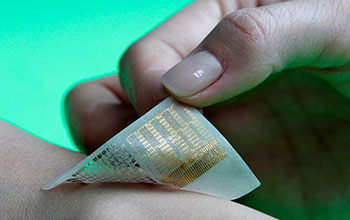| 


This prototype wearable device of an electronic skin patch is as thin as a temporary tattoo and can store and transmit data about a person's movements, receive diagnostic information and release drugs into skin.
Although there have been other efforts by researchers to develop "electronic skin," this device is the first with the capability of storing information and also delivering medicine, combining patient treatment and monitoring.
The device was developed cooperatively by Nanshu Lu, a mechanical engineer at the University of Texas at Austin, and Dae-Hyeong Kim of Seoul National University in South Korea. The researchers layered a package of stretchable nanomaterials onto a material that mimics the softness and flexibility of skin. The resulting sticky patch houses a device roughly 4 centimeters long, 2 centimeters wide and 0.3 millimeters thick that contains sensors, RAM capabilities, microheaters and medicine.
The patch must adhere to skin through electrostatic force because using an adhesive would disrupt electrical connectivity.
"This technology could help electronics that interact with humans be more mechanically compatible," Lu. "In terms of application, its uses range from consumer products like rollable displays and solar cells to personal digital health care like EKG and emotion sensors to computer gaming."
Lu received support from a National Science Foundation grant (CMMI 13-01335) to study the mechanics at the bioelectronics interface. The researchers reported their findings in Nature Nanotechnology. Credit: Donghee Son and Jongha Lee |
Nenhum comentário:
Postar um comentário
Observação: somente um membro deste blog pode postar um comentário.